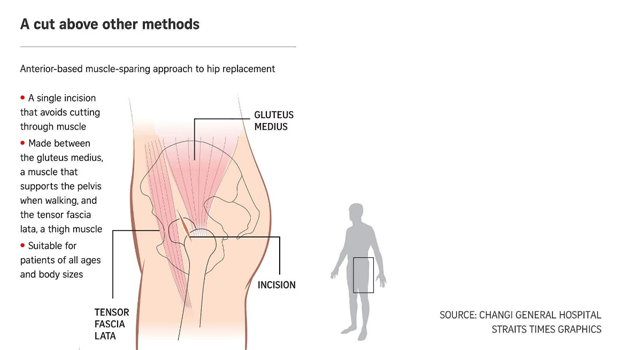SINGAPORE - After a bad fall in a carpark in February 2023, retiree Tang Yau Chng’s right hip started to really trouble him.
The active 75-year-old, who enjoys badminton, running and golf, had previously experienced occasional stiffness, but now the pain was starting to affect his daily life.
“I couldn’t really walk long distances and found it difficult to climb stairs,” said Mr Tang, a grandfather of five who used to work in sales marketing.
He sought help at Changi General Hospital (CGH) and was diagnosed with osteoarthritis, a degenerative joint disease which commonly causes gradual damage to the hip joint.
In November 2023, Mr Tang underwent hip replacement surgery using a new surgical technique that promises faster recovery, less pain and fewer complications.
Patients who underwent it at CGH spent an average of one to two days in hospital.
Known as the anterior-based muscle-sparing (ABMS) approach, this procedure does not require cutting through muscle – some other methods do, which results in longer recovery times.
“My wound healed without any complications or infection, and about a week after surgery I could walk unsupported,” said Mr Tang.
Since July 2023, 30 CGH patients have had their hips replaced using this new surgical approach.
Dr Moo Ing How, a consultant at CGH’s department of orthopaedic surgery, and the first surgeon at CGH to be trained in this technique, said: “Unlike the conventional methods for hip replacement surgery, the new approach is more versatile as it can be applied to a wider range of patients, especially senior patients, to achieve faster recovery and an enhanced quality of life post-surgery.”
There are several surgical techniques that can be used for hip replacements, said Dr Moo.
Conventional methods include the posterior approach, in which the surgeon cuts through the buttock muscles for a clearer view of the hip joint; and the lateral approach, in which the muscle that supports standing and walking, the gluteus medius, is split to expose the hip joint.
These two methods have a longer recovery time and cause more pain as they cut through muscles, said Dr Moo.
Some time after 2016, CGH began using a technique called the direct anterior approach, in which doctors make a cut near the groin area to place the hip implant, thus sparing the muscles.
However, as the incision is near a naturally moist area and sensory nerve of the thigh, a study published in 2019 in The Bone & Joint Journal found that 8.5 per cent of patients experienced wound complications.
Dr Moo said the newer ABMS approach cuts through a space between two muscle groups in the front of the hip, which makes for less blood loss and pain as the hip joint is accessed without cutting or splitting a single muscle.
As the incision is smaller and made further away from the groin area, patients’ surgical wounds are able to heal faster and with significantly less chance of wound complications and infections. Total recovery is expected within just one month after surgery, said Dr Moo.
In a study published in July 2022 in the Arthroplasty Today journal, the average blood loss during surgery was lower for patients who underwent the newer ABMS approach, compared with those who underwent the direct anterior approach, and only 0.5 per cent of ABMS patients required a blood transfusion post-surgery.
The ABMS method was first described in 2004, and has gained popularity in the last 10 years. But while it is widely practised in countries like the United States and Germany, it is relatively new in Singapore.
Dr Moo underwent a year’s training starting in August 2022, which included a trip to the US to observe procedures.
CGH also carried out specialised training for the care team in the operating theatres, including nurses, to perform the operation.
An average of 1,900 patients undergo hip replacement surgery each year in Singapore, and with the ageing population, demand for hip replacements is expected to remain high.
“All the approaches have their uses, and it’s a multifactorial decision-making process on which approach we choose for a patient,” said Adjunct Associate Professor Andy Yeo Kuei Siong, chief of CGH’s department of orthopaedic surgery.
For example, the posterior approach is ideal for complex hip surgery or patients who require a second revision surgery.
Meanwhile, the direct anterior approach is suitable for patients who are not significantly overweight, have no femur deformities and have normal pelvis anatomy.
“This new ABMS approach has been gaining popularity and, based on studies so far, there are additional benefits. That’s why we are aiming to increase our repertoire of approaches, such that we can offer any of the approaches to our patients,” said Prof Yeo.

Get updates on Tomorrow's Medicine in your mailbox!
Click here to subscribe
